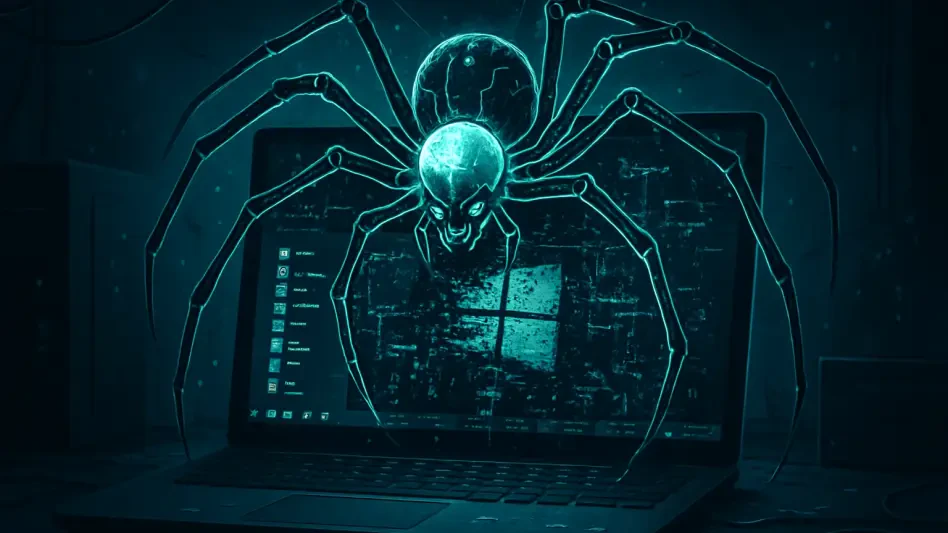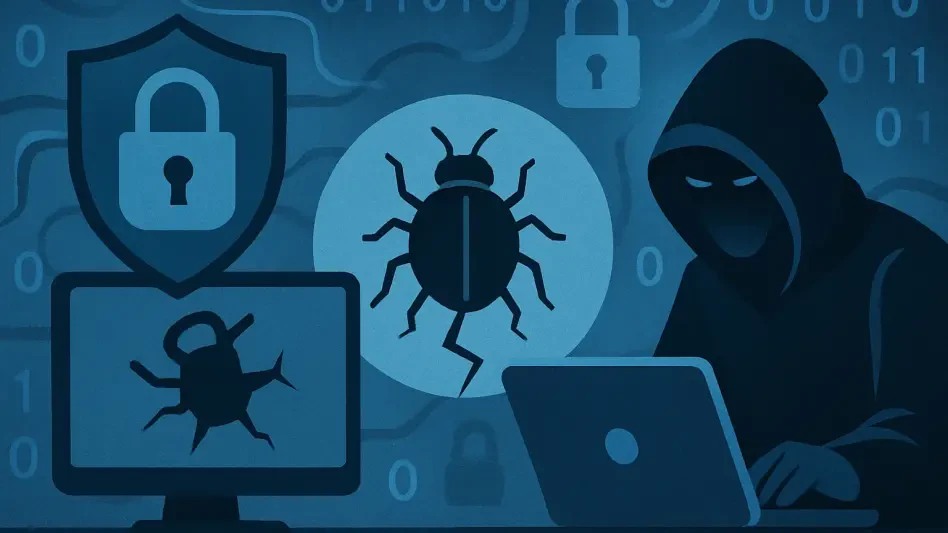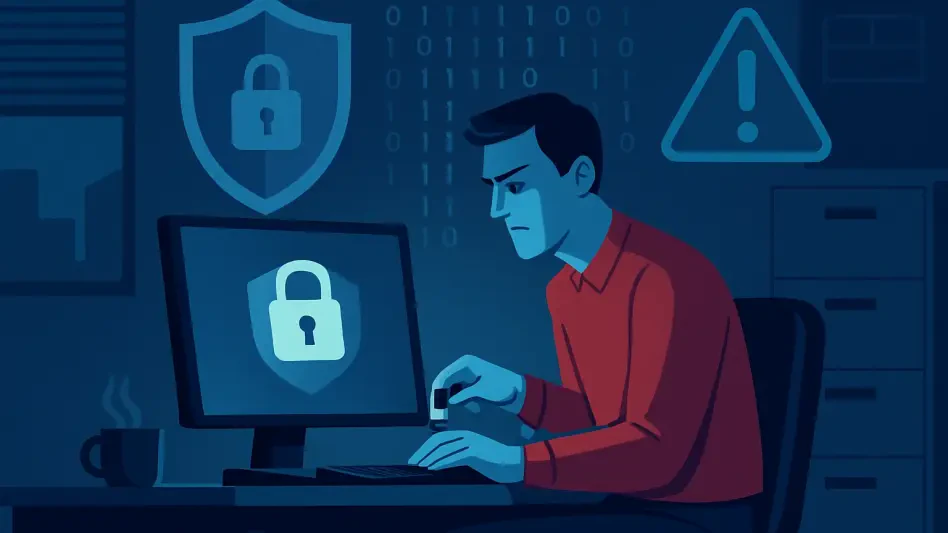In a chilling reminder of the ever-evolving dangers lurking in the digital realm, a sophisticated cyberattack orchestrated by the Lunar Spider group has exposed the vulnerability of Windows systems to a mere single click. This incident, which unfolded with alarming precision, showcases how cybercriminals can transform an innocent user action into a gateway for credential theft and prolonged unauthorized access. By leveraging advanced malware and exploiting systemic weaknesses, the attackers maintained a stealthy presence for nearly two months, harvesting sensitive data and escalating privileges with devastating speed. The implications of such an attack resonate deeply in a world increasingly reliant on digital infrastructure, raising urgent questions about the adequacy of current cybersecurity measures and the need for heightened vigilance.
Unpacking the Attack Mechanics
Initial Breach Through Deceptive Means
The attack began with a cunningly disguised JavaScript file masquerading as a legitimate tax document, luring an unsuspecting user to execute it with a single click. This file, heavily obfuscated with filler content to bypass detection, initiated a multi-stage infection process by downloading a malicious MSI package. From there, a Brute Ratel DLL was deployed using the legitimate Windows utility rundll32, seamlessly blending into routine system operations. This initial breach exemplifies the sophisticated social engineering tactics employed by Lunar Spider, capitalizing on human error to gain a foothold. The speed at which the attack unfolded—moving from click to compromise in under an hour—underscores the critical importance of user awareness and robust endpoint protection to thwart such deceptive entry points before they escalate into broader threats.
Beyond the initial deception, the attackers demonstrated a keen understanding of Windows architecture to embed their malicious payload. By exploiting legitimate processes, they evaded basic security scans that often overlook trusted system utilities. The use of a seemingly innocuous file name further masked their intent, making it challenging for even seasoned IT professionals to spot the anomaly. This phase of the attack highlights a growing trend in cybercrime where attackers prioritize stealth over brute force, meticulously crafting their approach to blend into the digital environment. As threats like these become more refined, organizations must invest in advanced threat detection tools and continuous monitoring to identify and neutralize such covert intrusions at the earliest possible stage.
Escalation and Credential Harvesting Tactics
Once inside the system, Lunar Spider wasted no time in deploying Latrodectus malware, which was injected into processes like explorer.exe to harvest credentials from an array of applications. Targeting 29 Chromium-based browsers, Mozilla Firefox, and Microsoft Outlook configurations, the malware accessed registry keys and database files to extract sensitive data. This rapid credential theft, executed within the first hour of compromise, illustrates the attackers’ focus on maximizing data collection early in the intrusion. The breadth of targeted platforms reveals a calculated strategy to capture a wide range of user information, posing severe risks to both individual privacy and organizational security.
The escalation did not stop at data theft; within three days, the attackers uncovered plaintext domain administrator credentials in an unattend.xml file, a glaring misconfiguration that granted them unfettered access across the network. This discovery enabled lateral movement, allowing Lunar Spider to deepen their control over the compromised environment. Such rapid privilege escalation underscores the dangers of unsecured configurations in automated deployment processes, often overlooked in routine security audits. The incident serves as a stark reminder that even small oversights can have catastrophic consequences, emphasizing the need for stringent access controls and regular system hardening to prevent attackers from exploiting these critical vulnerabilities.
Implications and Defense Strategies
Persistent Threats and Evasion Techniques
Lunar Spider’s ability to maintain a presence in the compromised system for nearly two months speaks volumes about their mastery of persistence and evasion. By injecting malicious code into legitimate Windows processes like sihost.exe and spoolsv.exe, alongside using Registry Run keys and scheduled tasks, the attackers ensured their foothold remained undetected. Their use of multiple command and control (C2) frameworks, including Brute Ratel, Latrodectus, and Cobalt Strike, provided redundant communication channels, further complicating efforts to sever their access. This prolonged dwell time, marked by intermittent C2 activity, highlights the challenge of rooting out well-resourced adversaries who prioritize stealth over immediate disruption.
Data exfiltration emerged as a primary objective, with the attackers conducting a ten-hour operation on day twenty to transfer data from file share servers using a renamed Rclone binary over FTP. Notably absent was the deployment of ransomware, suggesting a strategic focus on data theft for espionage or monetization rather than destruction. This shift in cybercriminal priorities demands a corresponding evolution in defense tactics, where continuous monitoring and anomaly detection become indispensable. Organizations must adopt a proactive stance, leveraging threat intelligence to anticipate and disrupt such persistent threats before they culminate in significant data loss or compromise.
Strengthening Defenses Against Sophisticated Attacks
Reflecting on this incident, it becomes evident that traditional security measures fall short against adversaries employing advanced evasion tactics. The rapid escalation to domain-wide access, driven by exposed credentials and process abuse, necessitates a multi-layered defense approach. Endpoint detection and response (EDR) solutions, paired with regular security awareness training for employees, can significantly reduce the risk of initial breaches triggered by user error. Additionally, securing system configurations to eliminate plaintext credential storage must be a priority to prevent privilege escalation, a tactic that proved pivotal in this attack.
Looking back, the response to this breach also revealed gaps in timely detection and mitigation, allowing attackers to operate undetected for an extended period. Future considerations should include investing in advanced behavioral analysis tools to identify subtle indicators of compromise, even when attackers hide within legitimate processes. Collaboration across industries to share threat intelligence can further bolster collective defenses against groups like Lunar Spider. Ultimately, the lessons learned from this attack in the past must inform actionable steps today, ensuring that systems are fortified and response mechanisms are swift to counter the evolving sophistication of cyber threats.








